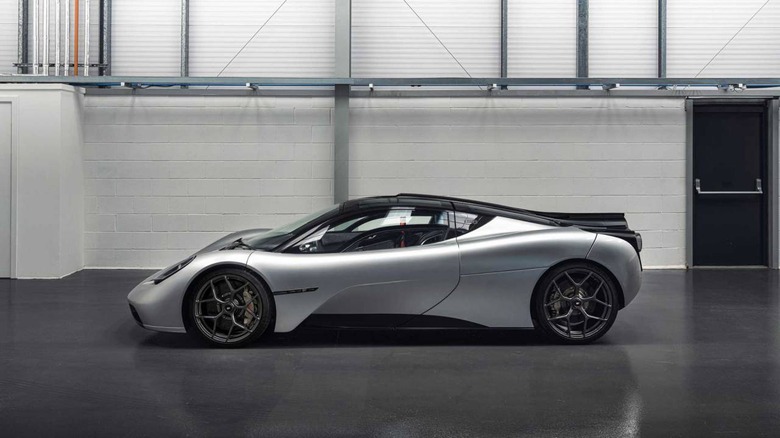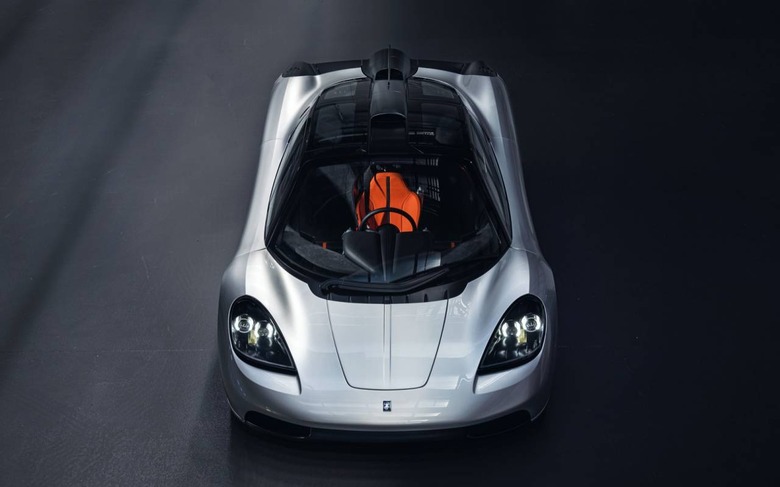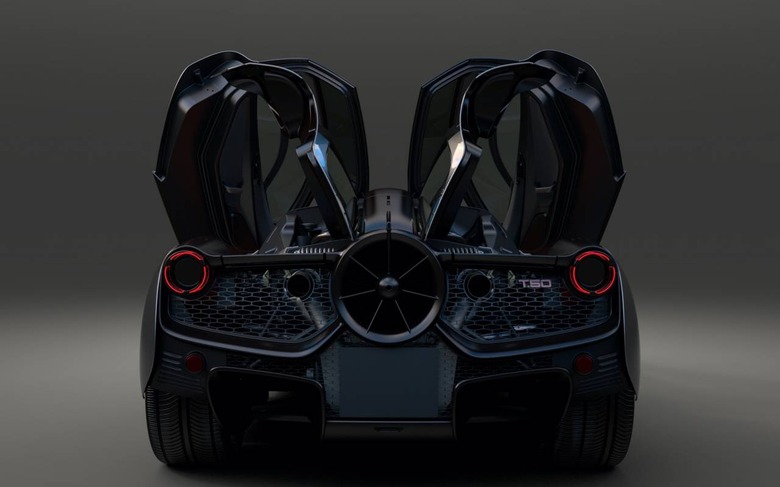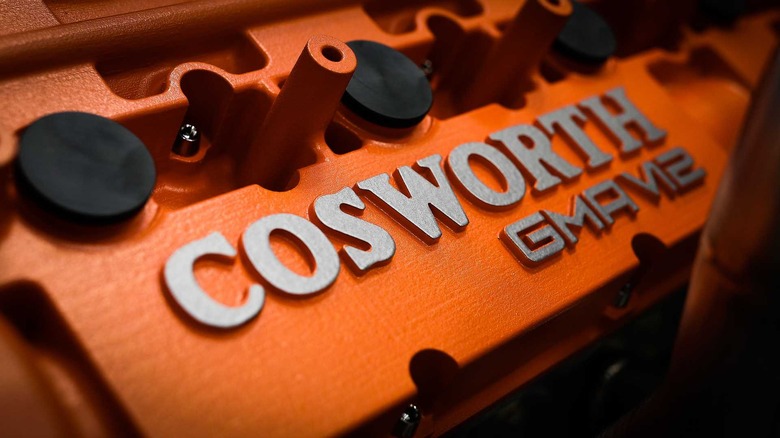Top Reasons Why Gordon Murray's T.50 Fan Car Is Rewriting The Supercar Doctrine
We first caught wind of Gordon Murray's T.50 supercar in June of last year. According to Murray himself, the new T.50 is the purest expression of a driver's car. "The T.50 is the lightest, most driver-focused supercar ever, and one which improves upon its iconic predecessor in every way."
Well, its finally here, albeit in pre-production prototype form. Gordon Murray Automotive (GMA) was established in 2017, and the first T.50 concept came to life in 2018. The '50' in T.50 refers to it as the fiftieth road or race car designed by Gordon Murray.

From the looks of it, the GMA T.50 is rewriting the supercar rulebook. Where other exotic carmakers are focusing on achieving the fastest lap time, top speed, or horsepower output, the GMA T.50 is the exact opposite. And yet, Murray himself promises it'll be the best driving experience you'll ever find in a modern road car.
Here are the top reasons why the GMA T.50 is worth every penny of its $3-million price tag.
It’s a Gordon Murray fan car
Need we say more? For our younger readers, here's a quick summary. Professor Gordon Murray CBE is a British designer of Formula One racing cars. Murray is also responsible for the McLaren F1 road car, a car of many firsts. It was the first to have an all carbon-fiber body; the first to have active aero and active brake cooling, and is the first to reach 240 mph among other production cars.
And, unbeknownst to many, the McLaren F1 is also a fan car, which makes the GMA T.50 the spiritual successor of the former. The F1 became one of the most iconic engineering feats in the entire industry. In fact, a pristine McLaren F1 sold at auction for an unbelievable $15,620,000 in 2017.
Gordon Murray is also responsible for the Brabham BT46B F1 car, more popularly known as the 'Brabham fan car.' It debuted at the 1978 South African Grand Prix and is easily distinguishable with its large ground-effects fan at the back.
Let’s talk more about that fan, shall we?
When Gordon Murray was conceptualizing the T.50, he had two goals in mind. First, to create the best-engineered car on the planet, bar none. And second, to create the best driving experience among any sports car or supercar (whether electric, gasoline, hybrid, or otherwise).
To achieve this, the car needs to handle like a dream, and how the air travels over and under the car has a lot to do with high-speed cornering and stability. According to Murray, the T.50 has a 40 cm aero fan that works on the principle of 'boundary layer control.' Simply put, the fan works by sucking the car to the ground and creating downforce as required.
The fan works in conjunction with two active aero wings at the back along with undercarriage aero ducts to channel air. The GMA T.50's trick ground-effects system has six aero modes. AUTO mode optimizes the fan, rear spoilers, and undercarriage ducts depending on current speed and road conditions. But in BRAKING mode, the rear aero wings fully open while the fan spins at maximum speed to double the downforce. This configuration results in shorter braking distances.

In HIGH DOWNFORCE mode, however, the fan and the rear spoiler work together to produce 30-percent more downforce. STREAMLINE mode closes the rear spoiler and the undercarriage ducts while spinning the fan at maximum speed. This helps to create a long-tail effect at higher speeds, and it does so without needing an actual long-tail rear end like in a McLaren Speedtail or the record-breaking Bugatti Chiron.
The GMA T.50 also has a VMAX mode. In this aero mode, the configuration is similar to STREAMLINE mode, but the car is churning out 30 more horsepower using energy generated by the 48-volt integrated starter-generator, and it can do this for 3 minutes to achieve the highest possible top speed. GMA0claims the T.50 has a theoretical 277 mph top speed.
The GMA T.50’s naturally-aspirated V12 is astonishing
The numbers are mind-boggling, to say the least. The GMA T.50 has a 3.9-liter naturally-aspirated V12 motor developed by Cosworth and GMA. It produces 650 horsepower and has a 12,100 rpm rev limit. This magnificent engine picks up at 28,400 revolutions per second.
This means the engine spins from idle to max rev (12,100 rpm, remember?) in less than 0.3-seconds. No other engine spins this quickly, and no other production motor can rev higher than this monster. And what's more incredible is the entire package only weighs 392 pounds, which makes it the lightest road-going V12 motor ever made.
The T.50 weighs less than an average supercar
The GMA T.50 is also the lightest supercar ever made. It tips the scales at 986kg or 2,174 pounds, making it lighter than a Bugatti Chiron or Aston Martin Valkyrie. The body and chassis are made from carbon fiber and all the other components are obsessively chosen to reduce weight. For example, the exterior body panels and monocoque cage only weigh 331 pounds.
For comparison, the Mitsubishi Mirage only weighs between 905 to 940kg or roughly 1995 to 2,072 pounds, but the Mirage doesn't have a high-revving V12 motor. The GMA T.50 is an inch shorter than a Porsche 718 Cayman. But unlike the Cayman, the T.50 has three seats, a central driving position, and enough luggage room for a weekend getaway. Consider this: The GMA T.50 has a better power-to-weight ratio than a Ferrari LaFerrari and McLaren P1 GTR.
The windscreen wipers produce downforce
Yes, even the T.50's windscreen wipers are aerodynamically-optimized to produce downforce. In the McLaren F1, the standard wipers rise above the glass as the speedometer reaches 150 to 160 mph. The solution was to install some aero fins on the wipers at the last minute. But not on the GMA T.50.
The wipers are milled from a solid piece of aluminum. The two wiper blades form the necessary airfoil to produce downforce. According to Murray, the wipers alone produce half a kilo of downforce.

We love the fact the GMA T.50 is not about lap times, horsepower figures, and top speed. And with base prices starting at $3-million (£2.36 million plus taxes), this exclusive supercar is definitely one for the books.





